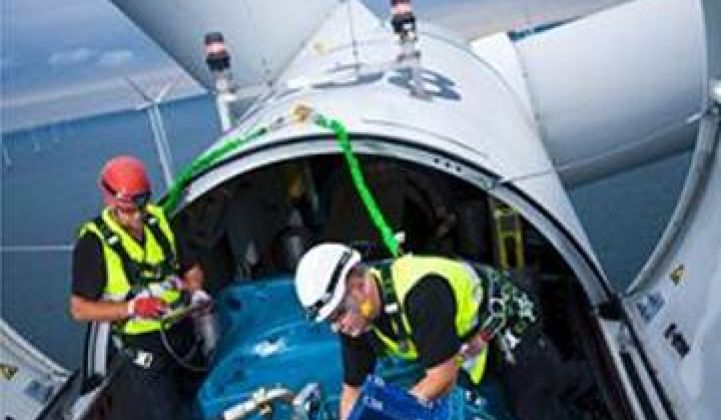“The first modern offshore wind farm became operational in 1991 off the coast of Denmark,” Lanard told the subcommittee of the House Natural Resources Committee. Europe now has over 40 operational offshore wind farms with an installed capacity of 2,396 megawatts. Sixteen more projects, representing an additional 3,972 megawatts, are under construction there. China, he added, has only 102 megawatts of offshore wind now in operation but some 2,300 megawatts are in some stage of construction.
“Yet in the United States, no offshore wind farms have been built,” Lanard said. That, however, is about to change, he added, thanks in no small part to Obama Administration initiatives. “We applaud President Obama, U.S. DOI Secretary Ken Salazar, U.S. DOE Secretary Steven Chu, and their staffs for their leadership on the continuing development of the offshore wind industry,” Lanard told the subcommittee.
In a private conversation following his testimony, Lanard further praised the work of Interior Department Deputy Secretary David Hayes on behalf of offshore wind. He “has formed a secretariat-level task force that goes across all executive branch departments in the national government and they meet as needed to ensure that at the highest levels in the Obama Administration there is communication and coordination both across departments and within the departments, in every possible agency,” Lanard said. “Just for offshore wind.”
Precisely according to the timeline in Interior’s Smart from the Start initiative, announced earlier this year by DOI Secretary Ken Salazar, federal Wind Energy Areas (WEAs) have been identified for development.
“In 2010, eight offshore wind developers bid to lease land on the outer continental shelf [OCS] off the coast of Maryland,” Lanard said. Also in 2011, “Ten offshore wind developers bid in the leasing process for federal waters off Massachusetts and eleven put in bids for the OCS off New Jersey,” Lanard added.
“Next, according to Smart from the Start, there will be an environmental assessment of the WEAs,” Lanard said. The first assessment -- of New Jersey, Maryland, Virginia and Delaware -- is due in the first part of July. “It will show the pathway for how a developer can get what might be called a ‘conditional lease’ for a wind farm, provided it meets the standards in the environmental assessment.”
An environmental assessment determines if a full Environmental Impact Statement (EIS) is needed. If it concludes that an EIS is not necessary, the assessment is deemed a Finding of No Significant Impact (FONSI). The areas sought for offshore wind development lease evaluations are expected to return FONSIs.
“The most important thing about this heavily conditioned permission to evaluate a lease site,” Lanard said, “is that once you have it, it prevents conflicting use from occurring there.” This protects developers who spend millions of dollars in site assessment from those who might “show up when the work is done and say ‘Me too.’”
“We need site certainty and this is what the Department of the Interior initiative has done so well,” Lanard said.
In addition, Smart from the Start, which Lanard called “very elegant,” postpones the time- and cost-consuming full EIS until actual construction is pending. Developers believe these early federal assessments will reduce the permitting procedure by as much as two years, decreasing it from a seven- to nine-year process to a five- to seven-year period, without compromising environmental protections.
It is the success of these Obama Administration policy initiatives that has caused some Congress watchers to question the motives of the Republican-led House subcommittee initiatives on OCS offshore wind permitting matters. In the hearing at which Lanard testified, seven of the eight presenters reportedly told the subcommittee it is not permitting but Republican-led withholding of incentives such as tax credits, loan guarantees and R&D funding that is the obstacle.
Some insiders believe the House subcommittee is laying groundwork for streamlining the OCS oil and gas drilling permit process by “greening” the concept ahead of time. Doubts were reinforced when the Republican sponsor of one of the initiatives failed to appear at the hearing where it was to be considered after questions about its value were raised.
Nevertheless, it looks very much like the U.S. offshore wind industry is about to achieve the scale it needs to boom. “Economies of scale can be achieved for offshore wind,” Lanard said, because they are ready to make a technological leap.
“Several offshore wind developers,” Lanard said, “have reported that they plan to propose wind farms scaled at 1,100 megawatts each.” And, Lanard said, “The standard going forward will be five-, six- and seven-megawatt turbines.”
The financial undertaking is proportionately bigger. “These wind farms are likely to cost more than three billion dollars,” Lanard said.
That is a lot of money. But it is a fraction of the cost of a new coal or nuclear plant of comparable capacity.
When and where wind will get into U.S. waters is the next big question. It looks like pilot projects off Rhode Island and New Jersey are in a race with those off Galveston in Texas’ Gulf of Mexico and off Cleveland in Lake Erie.



